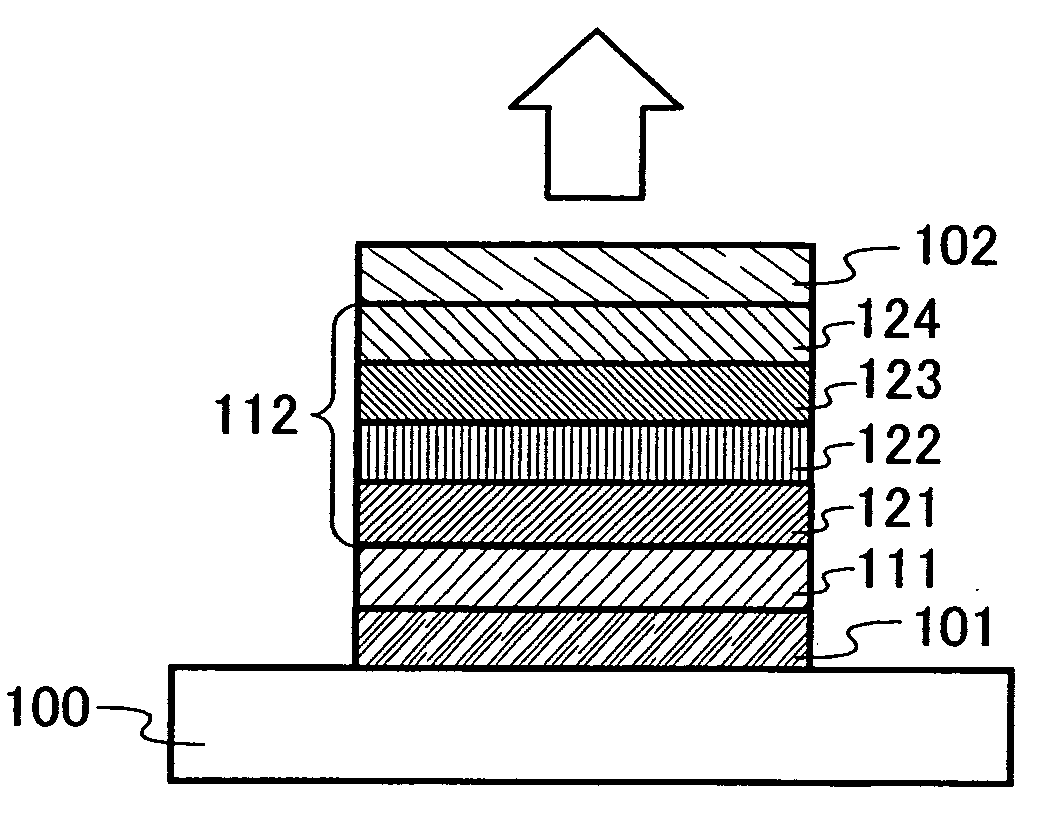Light-emitting device, electronic device, and manufacturing method of light-emitting device
- Summary
- Abstract
- Description
- Claims
- Application Information
AI Technical Summary
Benefits of technology
Problems solved by technology
Method used
Image
Examples
embodiment mode 1
[0030]Embodiment Mode 1 will describe a light-emitting element having a structure in which reflection of light entering the light-emitting element from outside (external light) is suppressed.
[0031]FIG. 1 illustrates a light-emitting element in which a first electrode 101 formed over a substrate 100, a second electrode 102 opposite to the first electrode 101, a first layer 111 and a second layer 112. The first layer 111 and the second layer 112 are formed sequentially over the first electrode 101, and are between the first electrode 101 and the second electrode 102.
[0032]The substrate 100 is used as a support of the light-emitting element. For the substrate 100, glass, plastic, or the like can be used, for example. Any material other than these materials may be used as long as it functions as the support of the light-emitting element. In addition, the substrate 100 may include a structure of an interlayer insulating film or the like. If light is extracted to the outside through the s...
embodiment mode 2
[0085]Embodiment Mode 2 will describe a light-emitting element with a structure different from the structure shown in Embodiment Mode 1. In this embodiment mode, a light-emitting element in which a light-absorbing layer is provided in contact with an electrode serving as a cathode is described with reference to FIG. 3.
[0086]FIG. 3 illustrates a light-emitting element in which a first electrode 301 formed over a substrate 300, a second electrode 302 opposite to the first electrode 301, and a first layer 311, a second layer 312 and a third layer 313 sequentially formed between the first electrode 301 and the second electrode 302 are provided.
[0087]In FIG. 3, the substrate 300 is used as a support of the light-emitting element. The substrate 300 can have a structure similar to the substrate 100 in Embodiment Mode 1.
[0088]In this embodiment mode, the light-emitting element includes the first electrode 301, the second electrode 302, and the first layer 311, the second layer 312 and the t...
embodiment mode 3
[0103]Embodiment Mode 4 will describe a light-emitting device including a light-emitting element of the present invention.
[0104]In this embodiment mode, a light-emitting device having the light-emitting element of the present invention in a pixel portion is described with reference to FIGS. 7A and 7B. It is to be noted that FIG. 7A is a top view showing the light-emitting device and FIG. 7B is a cross-sectional view taken along line A-A′ and B-B′ of FIG. 7A. This light-emitting device includes a driver circuit portion (source side driver circuit) 601, a pixel portion 602, and a driver circuit portion (gate side driver circuit) 603 in order to control the light emission of the light-emitting element. Also, a reference numeral 604 represents a sealing substrate, a reference numeral 605 represents a sealant, and the inside that is surrounded by the sealant 605 is a space 607.
[0105]A leading wiring 608 is a wiring for transmitting a signal to be inputted to the source driver circuit 601...
PUM
 Login to View More
Login to View More Abstract
Description
Claims
Application Information
 Login to View More
Login to View More - R&D
- Intellectual Property
- Life Sciences
- Materials
- Tech Scout
- Unparalleled Data Quality
- Higher Quality Content
- 60% Fewer Hallucinations
Browse by: Latest US Patents, China's latest patents, Technical Efficacy Thesaurus, Application Domain, Technology Topic, Popular Technical Reports.
© 2025 PatSnap. All rights reserved.Legal|Privacy policy|Modern Slavery Act Transparency Statement|Sitemap|About US| Contact US: help@patsnap.com



